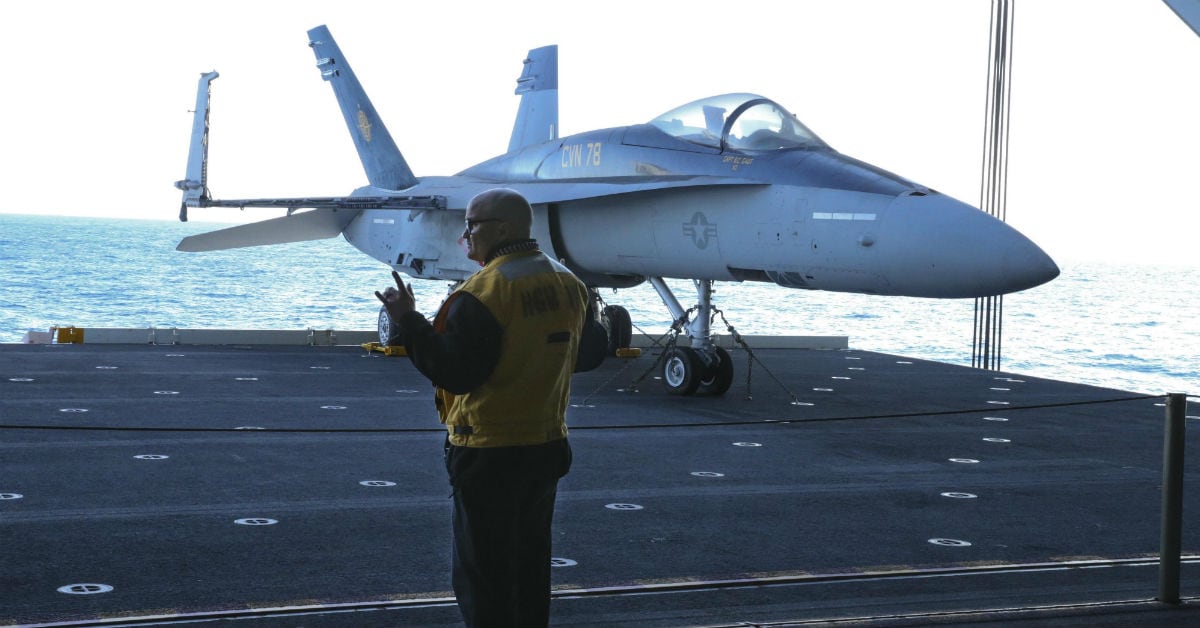A Navy report released last month is again raising questions about whether the service’s newest technology for launching jets from aircraft carriers is up to the task.
The $12.9 billion carrier Gerald R. Ford features for the first time the so-called Electromagnetic Aircraft Launch System, or EMALS, which replaces traditional steam-based carrier launch systems.
But while reports last summer said that EMALS had worked in launching a handful of aircraft, a January report from the Navy’s weapons testing department warns that the system and others may not be ready for a fight.
“Poor or unknown reliability of the newly designed catapults, arresting gear, weapons elevators, and radar, which are all critical for flight operations, could affect the ability of (the carrier) to generate sorties, making the ship more vulnerable to attack, or create limitations during routine operations,” the Director, Operational Test and Evaluation, or DTOE, report states.
President Trump said the Navy should return to “goddamned steam” on its new carriers during an interview last year.
“What is digital?” he said in a Time interview. “It’s very complicated. You have to be Albert Einstein to figure it out…the digital costs hundreds of millions of dollars more and it’s no good.”
The “poor or unknown reliability” of these systems poses the most significant risk to the new super carrier (CVN 78), the most expensive and high-tech ship ever built, according to the report.
RELATED

“Based on current reliability estimates, CVN 78 is unlikely to be able to conduct the type of high-intensity flight operations expected during wartime,” the report warns.
It also states that the carrier would be unable to meet its requirements for daily sorties.
New design features, such as a larger flight deck, dedicated weapons handling areas and more aircraft refueling stations on the Ford aim to enhance its jet launch and landing capabilities.
It led the Navy to set the Ford’s sorties requirement at 160 per day on a 12-hour fly day, with a surge potential to 270 sorties a day during a 24-hour surge, according to DTOE.
By comparison, the Nimitz-class’s sortie requirement is 120 for 12 hours and 240 for 24 hours.
The report states that the testing department plans to assess the Ford’s performance during its initial operational testing and evaluation, comparing it to the performance of the existing Nimitz-class carriers.
The Navy has previously flagged an inability to isolate EMALS and the Advanced Arresting Gear system for landing jets when maintenance is required, according to the report.
“This limitation will preclude some types of EMALS and (Advanced Arresting Gear) maintenance during flight operations, decreasing their operational availability,” the report states.
The Navy has already had to put in fixes for EMALS.
Testing in 2015 revealed excessive airframe stress during launches of F/A-18 and Growler jets when carrying external fuel tanks, but the DTOE states these problems have fixed.
EMALS-related questions are not the only issues plaguing the Ford, which was supposed to be delivered to the Navy in 2014 but was delayed and came in over budget.
While the Ford’s next-generation technology aims to reduce manning needs, the carrier is sensitive to manpower fluctuations, and workload estimates required for the new tech are not well understood, according to the report.
It is designed to hold up to 4,600 sailors, according to DTOE, but estimates have shown that the Ford will need to accommodate between 4,656 to 4,758 sailors for air wings, embarked staffs and detachments.
“Consequently, (the Ford) is expected to be short of berthing spaces,” according to DTOE.

It is also the first carrier to feature all gender-neutral bathrooms, and no urinals.
DTOE’s assessment comes after recent news that language has been inserted in to the fiscal 2018 defense bill that would allow the Ford to skip shock trials and deploy sooner.
Shock trials aim to assess a ship’s system under combat conditions.
If the Ford skips this step, it could see its maiden deployment in 2019 or 2020, instead of its originally scheduled date of 2022.
“The Navy is continuing to characterize the problems and develop mitigation plans, but current restrictions and performance of various systems will limit (the Ford’s) operations,” DTOE notes.
Some aviators have said they dig the new system.
Last summer, Lt. Cmdr. Jamie Struck of Air Test and Evaluation Squadron 23 said being shot off the deck felt different with EMALS.
“With the old steam catapults, there’s all that steam, that energy built up and as soon as that hold-back lets go, it can be kind of violent, a lot of bouncing before you get off the deck,” he told Navy Times. “EMALS was different…the hold-back release was less abrupt than what I’m used to, which is good.”
Geoff is the managing editor of Military Times, but he still loves writing stories. He covered Iraq and Afghanistan extensively and was a reporter at the Chicago Tribune. He welcomes any and all kinds of tips at geoffz@militarytimes.com.




